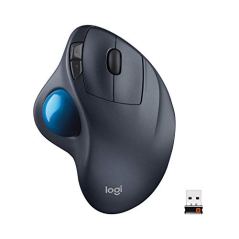
With great battery life and an easy-to-use trackball, this is a great solution for those wanting something different than a typical mouse.
With great battery life and an easy-to-use trackball, this is a great solution for those wanting something different than a typical mouse.
This mouse features two programmable buttons and a scroll wheel. Wireless connection can reach up to 30 feet. You can go up to 18 months before changing batteries. Sculpted shape provides comfort.
Like most trackballs, this one needs to be cleaned on occasion to keep it accurate.
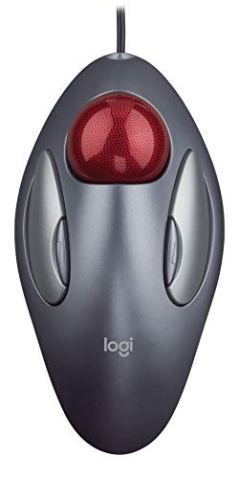
This is an easy-to-use, affordable trackball mouse for those who prefer a central location for their trackball.
This is an easy-to-use, affordable trackball mouse for those who prefer a central location for their trackball.
The optical sensor makes this trackball mouse very accurate. Trackball is lightweight and easy to move. The design makes it ideal for right and left-handed users.
This mouse does not include a scroll wheel, which many buyers noted that they missed.
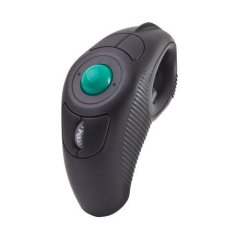
A great design for right-handed or left-handed people, but it isn't as customizable as some other brands.
A great design for right-handed or left-handed people, but it isn't as customizable as some other brands.
The central position of the trackball makes it easy to use in either hand. The handheld design makes it easy to use for those dealing with carpal tunnel. Works with all operating systems. Connects wirelessly up to 10 meters.
This mouse doesn't come with any software, so it's not programmable. Also, some buyers say the trackball is almost too sensitive and can be hard to get used to.
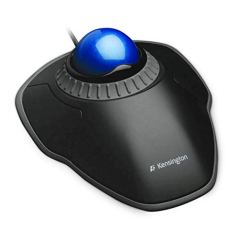
This trackball mouse can also be used whether you're right-handed or left-handed and has some great customization features.
This trackball mouse can also be used whether you're right-handed or left-handed and has some great customization features.
The software allows you to program the buttons and adjust the cursor and scrolling speeds. The unique scroll ring is easy to use and doesn't tire your hand. Two-button design. Compatible with Windows and Mac computers.
Several buyers noted that the trackball gathers dust and dirt more quickly than other brands, which requires more regular cleaning.
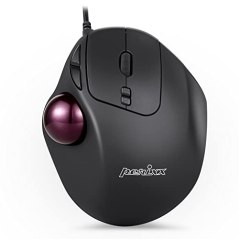
A reliable, easy-to-use trackball mouse that won’t break the bank and is compatible with most OS devices.
A reliable, easy-to-use trackball mouse that won’t break the bank and is compatible with most OS devices.
Adjustable DPI switch buttons let you customize how sensitive the mouse is to movement. Traditional scroll wheel is easy to reach and operate. Trackball can be removed from the mouse for cleaning, which is a unique feature among trackball mice.
Some consumers say the trackball feels loose or difficult to control after a few months of regular use.

We recommend these products based on an intensive research process that's designed to cut through the noise and find the top products in this space. Guided by experts, we spend hours looking into the factors that matter, to bring you these selections.

If you spend a lot of time in front of a computer, you’ve probably experienced hand or wrist strain from using your mouse. To alleviate strain, pressure, and cramping, consider making the switch to a trackball mouse.
A regular mouse is usually flat or triangular, which only puts the hand and wrist at awkward, uncomfortable angles. Trackball mice are ergonomically shaped to provide a more comfortable experience. In addition to their unique contouring, they also have a multidirectional ball located beneath your thumb or fingers. This eliminates the need to contort your arm and shoulder to move the cursor because you can simply roll it across the screen with a gentle flick of the thumb.

If you’ve only used a regular mouse, you’re well aware of the amount of effort it takes to manipulate it to move the cursor. In fact, you need to employ muscles from the hands all the way up to your shoulder to move one. As your hand and wrist aren’t in an ergonomic position, you might sustain injury with prolonged use.
A trackball mouse requires far less effort to move the cursor. Given its design, you only need to use your wrist and fingers to move it. This helps to alleviate tension and pressure in the hand, wrist, arm, and shoulder.
An easy way to narrow your search is to decide whether you prefer a wired or wireless trackball mouse. A wired mouse is ideal if you don’t want the extra cost of batteries, which you’ll need to buy for and replace in wireless models. With that said, the average wireless mouse can run anywhere from 6 to 18 months on a set of batteries.
If you’re interested in portability, a wireless trackball mouse is likely the better choice. These come with a USB receiver, which usually docks inside the mouse. Many wireless mice come with a carry case as well. While you can carry a wired trackball mouse in your bag, the cable means it takes up more room.
Before you begin comparing trackball mice, it’s important to know the operating system (OS) of your computer. Be sure to cross-reference it with the systems compatible with the mouse, because you’ll need to install or download the driver to recognize the mouse as a new, compatible peripheral.

Trackball mice have a much different shape than that of regular mice, which is attributed to their ergonomic design. The wrist sits in a relatively neutral position, while the hand is elevated to reach the trackball with minimal stretching or effort. You’ll also notice that trackball mice have a larger footprint than regular mice and provide a more comfortable platform for the entire hand-wrist area.
Size: There isn’t a standard trackball size, though it tends to range in diameter from approximately 1.3 to 2.8 inches. Smaller trackballs are considered an acquired taste and are often preferred by children or adults with smaller hands. A larger trackball has a universal appeal, but if it’s set too high in the mouse, it can be somewhat uncomfortable to use.
Location: The most common location for the trackball is just beneath the thumb on the side of the mouse. However, manufacturers have experimented with the location, especially in the past decade. Some newer models place the trackball just beneath the fingertips, while others place it in the middle of the mouse under the palm.
While the designs of trackball mice can differ from those of regular mice, they often have many of the same buttons. However, the buttons often have unique shapes and locations. Most trackball mice have the equivalent of right- and left-click buttons, as well as a scroll wheel.
More involved designs may have a dots per inch (DPI) button to adjust sensitivity to movement, as well as a wheel to scroll up or scroll down. There are also trackball mice with programmable buttons that allow you to set specific commands. This is an especially attractive feature if you’d like to reduce your overall number of keystrokes.
If you work in a quiet office or are sensitive to sound, invest in a trackball mouse with quiet operation. With these models, the clicking of the buttons is muffled by internal components to reduce their overall volume.
Mouse pad with wrist support: Fellowes Gel Crystal Mouse Pad
Enjoy additional support when using your trackball mouse when you invest in a mouse pad with wrist support. We like this one from Fellowes because the gel cushioning is soft and contours to your wrist.
Keyboard wrist rest: Kensington Duo Gel Keyboard Wrist Rest
It’s important to have adequate support when using your keyboard, which is why it’s recommended that you invest in a wrist rest. This one from Kensington featured ventilated gel to keep hands cool and comfortable.
Trackball mice range in price from $25 to $100, mostly depending on the number of additional buttons or custom features.
Inexpensive: Entry-level trackball mice cost between $25 and $40. These mice are fairly simple, so it’s not unusual for them to only have the trackball and the right- and left-click buttons.
Mid-range: These trackball mice cost between $45 and $60 and include wired and wireless models. These last longer and are more responsive than cheaper models and are often equipped with programmable buttons.
Expensive: The most expensive trackball mice cost $70 to $100 and include specialized designs that are intended for use by advanced users. Not only do they have a wide variety of programmable buttons, but their ergonomic designs are far more comfortable than lesser-priced options.


A. While it seems like a small detail, if you’re left-handed, the location of the trackball can make or break your decision. The vast majority of mice, trackball and regular, are designed for right-handed users. Left-handed individuals often fare best with a mouse whose trackball is located in the middle. Many of these models have programmable buttons that allow lefties to fully customize their experience.
A. For superficial cleaning, you can simply use a can of compressed air to blast away dust, crumbs, or hair. If the mouse needs a deeper cleaning, it’s recommended that you use alcohol wipes. However, it’s important not to saturate the mouse in alcohol or you could damage the internal components. Some trackball mice can be taken apart for cleaning, and the ball can be removed, cleaned, dried, and replaced.
A. Those who have difficulty controlling the location of the cursor do well with a trackball mouse. Individuals in this category include those with hand injuries, arthritis, carpal tunnel syndrome, or people whose hands are prone to cramping. Trackball mice are also recommended for people who use their mouse continuously for prolonged periods of time. The mice combat fatigue and help maintain a healthy, ergonomic position of the hand and wrist.
Get emails you’ll love.
Learn about the products you’re wondering if you should buy and get advice on using your latest purchases.
